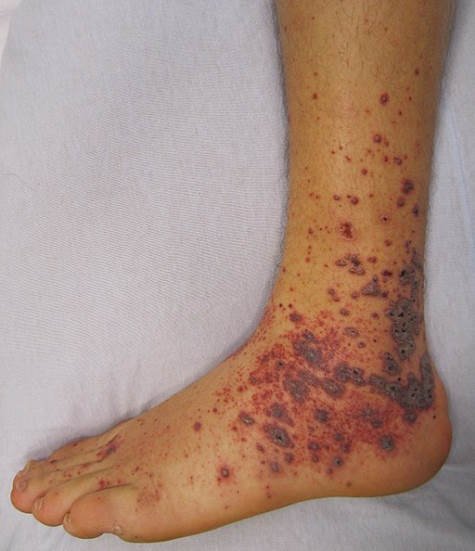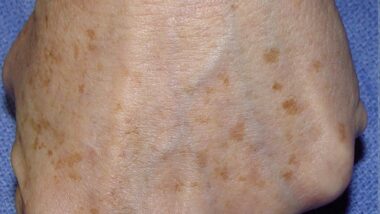The appearance of “purple spots on skin” arises for many reasons ranging from harmless to those that might be an indication of a serious health condition. Read on to discover what we have been able to compile here on purple skin spots from a variety of online resources. However, we are not medical experts and we must stress that in the event of any doubt at all, you must see a medical expert.
On This Page
- What Symptoms Might Occur With Purple Skin Spots?
- What Causes Purple Skin on Genitals or Upper Thigh?
- What Are Potential Complications of Purple Skin?
- Skin Symptom Warning Signs That May Occur Along with Purple Skin
- Pulmonary Symptoms That May Occur Along With Purple Skin and Purple Skin Spots
- Senile Purpura Symptoms That May Occur Along With Purple Skin
- Other Symptoms That May Occur Along With Purple Skin
- Causes of Purple Skin in Dogs
- Pulmonary Causes of Purple Skin
- Other Causes of Purple Skin
- Diagnosing ITP as the Cause of Purple Skin
What Symptoms Might Occur With Purple Skin Spots?
Purple spots on skin can range widely in size and shape. They might appear as lines, small or tiny dots, or large patches. They may occur as a result of different health conditions, but can be due to a skin condition is known as purpura. The spots can develop on various parts of the body, particularly on the face, chest, back, arms and legs. If you see any of this read on to explore facts, pictures, causes, signs, and symptoms of purple spots on the skin.
Also, learn how to get rid of them with medical treatments and home remedies.

So, what is purpura? Purpura, also called blood spots or skin haemorrhages refers to purple-coloured spots that are most recognizable on the skin. The spots may also appear on organs or mucous membranes, including the membranes on the inside of the mouth. Purpura occurs when small blood vessels burst, causing blood to pool under the skin. This can create purple spots on the skin that range in size from small dots to large patches. Purpura spots are generally benign but may indicate a more serious medical condition, such as a blood clotting disorder.
 To summarise: Purple or red-coloured spots on your skin are called purpura. These spots usually appear due to sub-dermal bleeding or skin haemorrhages. They can appear on the skin of body organs such as eyes, nose, mouth cavity, arms, legs or any other parts of your body. Basically, purple spots on your skin can show up in various signs and symptoms. These spots or patches are usually characterized by the following:
To summarise: Purple or red-coloured spots on your skin are called purpura. These spots usually appear due to sub-dermal bleeding or skin haemorrhages. They can appear on the skin of body organs such as eyes, nose, mouth cavity, arms, legs or any other parts of your body. Basically, purple spots on your skin can show up in various signs and symptoms. These spots or patches are usually characterized by the following:
- small or large raised purple spots on the skin surface
- flat purple patches on the skin that are irregularly shaped.
What Causes Purple Skin on Genitals or Upper Thigh?
Small dark purple or red spots on your genitals or your upper thigh could be a skin condition called angiokeratomas. Dermatologists say that these raised dark lesions are harmless but can bleed easily if scratched or damaged. The number of dark bumps can range from one or two to over 100. In older people, these dark spots tend to be black or dark blue in colour with a scaly look to them. There is often a red-purple, raised rash on the legs, buttocks or elsewhere. This is caused by red blood cells that leak out of the damaged blood vessels. It is always the best policy to obtain professional medical advice.
What Are Potential Complications of Purple Skin?
Acral lentiginous melanoma (ALM) is a rare type of skin cancer that is easy to overlook as it looks like a bruise under a finger or toenail. The discolouration may be black, brown, or purple. If you develop a discolouration under a nail, it’s best to have it checked out by a doctor. The famous reggae musician, Bob Marley, passed away in 1981 from complications of ALM melanoma which originated under a toenail.
The paper is far from the first to note the coronavirus may cause complications in the skin, with patients reporting ” covid toes”, or purple, swollen toes that look like they have been frostbitten, early on. In a Facebook group for coronavirus patients and survivors, people have reported fluid-filled blisters, full-body rashes, hives, red and purple spots, patches of skin that burn, chicken-pox-like bumps, and more. In some of these cases, the skin changes may be due to blood clotting in the skin's small blood vessels.
Purple bump on the inner thigh is a sickness of the thigh that can come about as a result of muscle strain, extreme temperatures that can cause purple bumps on the inner thigh due to rubbing of the thighs, bacterial infections, viral infections and even physical injuries. This condition can be an indication of a possible skin infection that should be taken with utmost seriousness, and one should have a checkup immediately to alienate possible further complications. Some of the causes of these infections are boils, rubbing of thighs, warts, blood clot swelling on inner thighs, sexually transmitted infections and even cancer!
Skin Symptom Warning Signs That May Occur Along with Purple Skin
It is advisable to see your doctor over purple spots on your skin if you notice the following conditions that include:
- when the purple spots, dots, mark or patches have persisted on your skin for a period of more than three weeks without healing
- when the purple spots on your skin are accompanied by other strange symptoms such as fever, headaches, dizziness, vomiting, and
- if your skin develops chronic purple spots that are itchy and makes you feel a discomfort
- when the purple spots on the skin develop into blisters, sores and wounds that refuse to heal.
Purpura is characterized by small purple spots on the skin, typically 4-10 millimetres in diameter. Some people develop larger patches of 1 centimetre or greater. These are called ecchymoses. Sometimes the spots can appear on mucous membranes, for instance, inside the mouth. Purpura tends to occur in clusters that are found in a single area or cover a large portion of the body. The larger the rash is, the greater the bleeding will often be. Unlike some other rashes, purpura will not change colour or blanch when pressed. The rash can look a lot like tiny clusters of bruises, but the skin should not be itchy or irritated which would suggest a cause other than purpura.
If you notice reddish-purple spots on your skin, it could be a sign of a major health issue. If the spots are accompanied by purpura symptoms, it’s advisable to book an appointment with your doctor right away for an official diagnosis. The purpura causes can be quite dangerous, so early action is recommended.
Pulmonary Symptoms That May Occur Along With Purple Skin and Purple Skin Spots
Medical illnesses such as strep throat and rocky mountain spotted fever are some of the many conditions that can cause blood spots under the skin, as noted by the Mayo Clinic. Such spots may appear on the chest, face and even on the neck as persons have been exposed to strenuous activities as we discussed above. These medical conditions can also occur after using some medications which may result in medication side effects such as quinine, naproxen and penicillin. Also, people suffering from Hantavirus pulmonary syndrome are likely to see some blood spots on the skin. These same symptoms are also associated with flu, and then more serious symptoms occur, such as fluid on the lungs and dangerously low blood pressure. Moreover, endocarditis is another condition associated with blood spots under the skin that strike the valves or inner lining of the heart, and it may show up flu-like symptoms in addition to bloody spots under the skin.
Purple skin is a common symptom of injury and of heart and lung disorders. Purple skin results from bleeding and bruising, broken blood vessels (haemorrhage), and low levels of blood oxygen (hypoxemia). Purple skin may occur in conditions affecting the skin itself or along with a more generalized disorder resulting from conditions such as drowning or chronic heart and lung diseases. Bruising from skin injuries is a common cause of purple skin. Other common causes include broken blood vessels and pooling of blood under the skin. Chronic obstructive pulmonary disease ( COPD, including emphysema and chronic bronchitis ) is commonly associated with purple skin, which may be accompanied by cough, difficulty breathing, and clubbing of the fingers.
If you recently returned from a scuba diving trip, barotrauma, an injury caused by changes in pressure, might be the cause of your itchy purple skin. One symptoms database indicates that “dive suit squeeze,” caused by a too-tight diving suit, can cause an itchy rash and patches of purple skin on the body. The symptoms might appear right after your trip or occur over time. Since some cases of barotrauma require surgery or medical treatment, it is generally recommended to schedule an appointment with your primary care provider if you suspect barotrauma.
Senile Purpura Symptoms That May Occur Along With Purple Skin
Found in elderly people who suffer from recurrent bleeding only in the skin and more in the exposed parts. It is not associated with any exogenous history. Symptoms of senile purpura include the following symptoms:
- spots and patches purple in colour generally found in the skin of the neck, back of the hands and the extensor surfaces of upper limbs
- the patches may leave a yellow or brown stain or occur as a chronic relapsing condition
- thin skin
- patches occur without trauma or injury
- purple or red purpuric and ecchymotic patches.
Bruises, blood spots, lung disorders, heart disorders, and lack of oxygen are some of the possible reasons behind purple spots on the skin.
If certain areas of your skin have become purple or you see some purple spots developing on your skin, important advice to you is not to take it lightly and immediately consult a doctor. This is especially true if they are accompanied by symptoms, such as difficulty in breathing, pain in the chest, a change of colour of the nails and the lips to blue and an increase in the heart rate. All these symptoms indicate that there could be an underlying serious problem behind your skin turning purple. However, this is not the only reason why purple spots occur on the skin. Sometimes, even a small injury can cause these to develop.
Other Symptoms That May Occur Along With Purple Skin
Call your doctor if any of the following occur during home treatment:
- a bruise lasts longer than 2 weeks
- signs of a skin infection develop
- symptoms become more severe or frequent
- new symptoms develop.
Petechiae are red, purple or brown and they can be so small and concentrated to look like a rash. They usually appear on your arms, legs, stomach, and buttocks. You might also find them inside your mouth or on your eyelids. These pinpoint spots can be a sign of many different conditions, some minor, others serious. They can also appear as a reaction to certain medications.
Causes of Purple Skin in Dogs
Skin discolouration is indeed a telling sign of cutaneous hyperpigmentation in canines, not only in dark purple or blue but sometimes in colours like black and pale brown, too. When dogs experience hyperpigmentation, not only does the skin's colour change a little, but its texture also often changes, frequently taking on a markedly dense and coarse feel. Hyperpigmentation doesn't only show up on dogs' stomachs, but also commonly on their limbs and where their lower stomachs and thighs meet.
Pulmonary Causes of Purple Skin
Bruises: one of the most common causes of purple spots are injuries which result in minor bruising. Bruises develop due to damage of the blood vessels present below the skin. The healing process of such bruises causes the affected skin area to change colours into maroon, red, brown, and purple. Cardiac and pulmonary conditions: there are some cardiac disorders like cyanotic heart disease, congestive heart failure, cardiomyopathy, and cardiogenic shock which cause purple spots on the skin, or purplish skin colour. The skin may also become purplish or elicit purple spots due to varied lung diseases, including bronchiolitis, pneumonia, a serious asthma attack, choking caused due to the presence of foreign matter in the airways, chronic obstructive pulmonary disease, epiglottitis, and croup. All the above-listed conditions are severe and require urgent medical attention.
Heart disorders, such as cyanotic heart disease, cardiac arrest, and heart failure, are common causes of purple skin. Rarely, purple skin is a symptom of a serious blood clot, such as a pulmonary embolism. Drug overdoses from sedatives, benzodiazepines or narcotics can cause purple skin. Obstructions in the airway, including choking, croup and epiglottitis, are further possible causes of purple skin. Additionally, prolonged seizures, high altitude, and cold air or water can all lead to purple skin. Purple skin can be a sign of a serious condition. If purple skin is accompanied by difficulty breathing or shortness of breath, rapid heart rate (tachycardia), chest pain or pressure, or bluish colouration of the lips or fingernails, seek immediate medical care (call 911).
There are certain disorders of the lung that may cause the skin to turn purple. Bronchiolitis, a severe asthma attack, pneumonia, chronic obstructive pulmonary disease, choking resulting from a foreign object in the airways, croup, and epiglottitis – these are some of the pulmonary disorders, which may cause the skin to turn purple. Certain heart disorders, such as congestive heart failure, cyanotic heart disease, cardiogenic shock and cardiomyopathy, may lead to changes in the skin colour to purple too. All these disorders and conditions are very serious, needing immediate medical attention.
Other Causes of Purple Skin
An inpatient dermatology consult has been assessing skin findings in covid-19 patients since the start of the pandemic. It is understood that a variety of rashes occur among hospitalized covid-19 patients. “the main finding we have noted is a pattern of lacy, red-purple rashes, some with skin necrosis, on the arms, legs, and buttocks in critically ill covid-19 patients,” the expert has said. Doctors have seen through skin biopsies that skin problems in more severe covid-19 patients are brought on by clotting in the small blood vessels in the skin. Often, those patients also have blood clots in their legs or lungs or have had strokes, indicating clotting problems throughout their bodies.
Blood spots under the skin may be either purpura or petechiae. Purpura might look like bruises, but they are not caused by an injury as most regular bruises are. Petechiae don't look like bruises. They are tiny, flat, red or purple spots in the skin, but they are different from the tiny, flat, red spots or birthmarks (hemangiomas) that are present all the time. Sudden unexplained bruising or blood spots under the skin or a sudden increase in the frequency of bruising may be caused by:
Diagnosing ITP as the Cause of Purple Skin
An itchy rash can pose a risk of infection if you constantly scratch it. A dark purple rash can also appear unsightly, which can make you self-conscious. Since diagnosing skin rashes requires the trained eye of a physician, schedule an appointment with your doctor if you experience any type of unexplained itchy purple rash or skin lesion.
If you have bleeding from your gums, mouth, or nose, or you have irregular or heavy menstrual bleeding consult your doctor. You have blood in your urine or bowel movement, consult your doctor. If you see more bruises or red or purple spots on your skin consult your doctor.
Peripheral vascular disease (Saunders. 1946). Purple feet can be a sign of poor circulation, which can be dangerous. But they can also be nothing to worry about. Cold exposure, vein disease and medications can result in purple discolouration of the feet. Diagnosing the cause requires asking the correct questions and choosing appropriate testing. Of course, treatment depends on the diagnosis and is different for each cause.
Immune thrombocytopenic purpura (ITP) is a condition which causes the number of platelets in your blood to be reduced. Platelets are what makes blood clot and they are needed to help you stop bleeding and bruising after an injury. A low platelet level does not usually cause symptoms as long as your platelet count remains above 50,000, which is typically the minimum needed to prevent abnormal bleeding. At lower platelet levels, ITP can cause different symptoms, depending on the type of ITP. Sometimes, the only symptom is the appearance of tiny purplish spots that show up on the lower legs. They are called petechiae. These are pinpoint size accumulations of blood under the skin caused by leaky small blood vessels. At very low platelet levels, ITP can cause different symptoms, depending on the type of ITP.
Sometimes, low platelet levels can cause excessive bruising and bleeding. Platelets are the cells that help your blood clot. Low platelet levels may be inherited or genetic. There are two kinds of purpura: nonthrombocytopenic and thrombocytopenic. Nonthrombocytopenic means that you have normal platelet levels in your blood. Thrombocytopenic means that you have a lower-than-normal platelet count. The following could cause nonthrombocytopenic purpura:
- disorders that affect blood clotting
- certain congenital disorders, present at or before birth, such as telangiectasia (fragile skin and connective tissue) or Ehlers-danlos syndrome.
Acute ITP may occur in which symptoms usually begin abruptly. In children, the trigger can be a viral infection, with ITP symptoms appearing one to three weeks after the infection resolves. In adults, the trigger for acute ITP may not be obvious. The first sign of the illness may be a red or purple skin rash on the legs or abnormal bruising after only minor trauma. There also may be small areas of bleeding or “blood blisters” on the surface of the lips or gums and frequent or severe nosebleeds.
What does skin with purple spots look like? To see how it might appear, we have included purple skin pictures in relevant parts of this post. The purpura pictures in this post might have a slight difference from the actual vision due to variations in skin tone. Despite the variation in skin colour, you can use pictures or images to evaluate the condition of your skin and get a hit about it. Nevertheless, you should not use these pictures or photos as your reference for self-diagnosis and treatment without the guidance of your doctor.
You are recommended by experts to consult your doctor if your blood spots on the skin occur suddenly, without a known cause and are spreading.
We include products we think are useful for our readers. If you buy through links on this page, we may earn a small commission.
I apologize for any confusion, but as an AI language model, I don't have the exact contents of your original article. However, I can provide general information based on the questions. Please consider this information as hypothetical and consult a healthcare professional for precise answers.
Frequently Asked Questions
What Symptoms Might Occur With Purple Skin Spots?
Along with the visible purple spots, symptoms could include itching, pain, or no symptoms at all. In some cases, underlying conditions may result in additional symptoms.
What Causes Purple Skin on Genitals or Upper Thigh?
Various factors can cause purple skin on these areas, including bruising, certain skin disorders like lichen planus, or sexually transmitted infections. Always consult with a healthcare provider for a proper diagnosis.
What Are Potential Complications of Purple Skin?
Potential complications depend on the underlying cause of the purple skin. They could include severe bleeding if it's due to a blood clotting disorder, or other complications related to the specific cause.
What Are the Skin Symptom Warning Signs That May Occur Along with Purple Skin?
Warning signs could include severe pain, rapid onset or spreading of the spots, associated fever, or bleeding from other areas. These signs should prompt immediate medical attention.
What Are the Pulmonary Symptoms That May Occur Along With Purple Skin and Purple Skin Spots?
Pulmonary symptoms such as shortness of breath, chest pain, or coughing up blood can occur if the cause of the purple skin spots is related to a lung or systemic disease.
What Are Senile Purpura Symptoms That May Occur Along With Purple Skin?
Senile purpura typically results in large, flat, purple spots on the skin, particularly on the arms and hands. These spots are often benign and are caused by the thinning of the skin and blood vessels due to age.
What Are Other Symptoms That May Occur Along With Purple Skin?
Other symptoms could include fatigue, joint pain, or symptoms related to an underlying condition like a blood clotting disorder.
What Causes Purple Skin in Dogs?
Purple skin in dogs could be due to bruising, skin conditions, or more serious issues like a clotting disorder or internal bleeding. Any changes in a pet's skin should be addressed with a veterinarian.
What Are the Pulmonary Causes of Purple Skin?
Pulmonary embolism or other severe lung diseases can potentially cause purplish discolouration of the skin due to lack of oxygen.
What Are Other Causes of Purple Skin?
Other causes could include certain medications, bleeding disorders, and vasculitis. Some autoimmune diseases can also cause purple skin spots.
How Is ITP Diagnosed as the Cause of Purple Skin?
ITP, or Immune Thrombocytopenia, is diagnosed through blood tests, and in some cases, bone marrow tests. The presence of low platelets with normal red and white blood cell counts can indicate ITP.
What Are the Different Sizes and Shapes of Purple Skin Spots?
Purple skin spots can vary widely, from tiny pinpricks to large patches, and can appear as lines, dots, or blotches.
What Is Purpura?
Purpura refers to purple-coloured spots that appear on the skin and mucous membranes when small blood vessels burst, causing blood to pool underneath the skin. The spots can indicate a more serious medical condition, such as a blood clotting disorder.
How Can I Get Rid of Purple Skin Spots With Medical Treatments and Home Remedies?
Treatment depends on the cause. For benign causes, no treatment may be necessary. Medical treatments could include treating the underlying cause or symptomatic relief for associated symptoms like itching. Home remedies might include rest, application of cold packs for bruises or over-the-counter creams to relieve symptoms. However, any treatment should be discussed with a healthcare provider.
[First posted Oct 23, 2020.]




